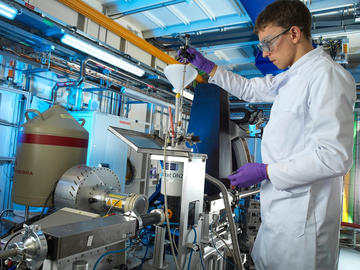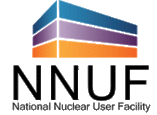Diamond Active Materials Laboratory

Delivering new opportunities for active materials research at Diamond Light Source: an Active Materials Laboratory.
PI: Prof Fred Mosselmans
Understanding structural change in materials due to operation and radiation damage is a major challenge for the nuclear industry and the academics working in this field. Scientific research is essential to provide evidence and support in decision-making, for instance when reviewing ageing infrastructure and making decisions to extend its lifetime or when designing brand new nuclear facilities. Diamond already offers analytical instruments for active materials research. The construction of a new dedicated Active Materials Laboratory building will significantly improve the capabilities for researchers ranging from those involved in construction materials for nuclear energy facilities to waste management.
Increased knowledge of active materials is essential for the community in many ways. It may concern how materials behave under radiation, such as engineering materials used in nuclear power stations. The UK is currently embarking on a new nuclear build programme, with large reactors in various stages of development and the small modular reactor programme beginning. This will call for advanced materials development and work on new fuels.
Other important aspects are to ensure safe storage and understanding interactions with the environment in decommissioning old sites of the UK's nuclear legacy.
The new Active Materials Laboratory

Overhead view of Diamond Light Source
© Diamond Light Source
The new building will have both wet and dry laboratories equipped for handling a wide range of active materials. There will also be a counting room for active materials to be characterised and a secure storage as appropriate.
The dry laboratory will house an argon glove box with an inbuilt microscope. This will enable sample cells, such as a bespoke cell for use in a loading rig on I12, to be assembled on-site before being taken in appropriate containment to a beamline. There will also be a fume hood containing a furnace so samples can be treated offline before being studied on a beamline.
The wet laboratory will house an argon glove box for handling samples that need to be kept dry and oxygen-free such as molten salts, a Coy anaerobic chamber for handling wet anaerobic samples, a fume hood, a centrifuge, and chemical store cupboards for common solvents and acids.
Beamline I12 and DIAD are investing in in situ loading rigs with tension, compression and cyclic capability. These will have a 10 kN capacity for time-resolved tomography and imaging. This 10 kN load capacity was specified to accommodate the broadest possible range of user requirements, from soft biomaterials and polymers to high strength engineering alloys. Bespoke cells are being procured to safely contain samples to go in the I12 rig. This rig will be fitted out with a furnace to enable in situ testing of active material under controlled environments at temperatures up to at least 800oC.
New possibilities for users

Callum Robinson, University of Manchester PhD student, demonstrating the loading of a sample containing uranium onto Diamond’s I20-scanning beamline
© Diamond Light Source
With the new laboratory, users will be able to manipulate and prepare (very) active and also relatively shortlived samples to study them at Diamond. Users will be able to do experiments at Diamond that were previously impossible in the UK. Being able to load samples into suitable sample cells means that active materials properties can be studied under temperatures and particular atmospheres. It is necessary to understand the impact of prolonged radiation on the mechanical performance of a range of materials such as graphite and Zircaloy used in fission and fusion facilities.
Understanding the corrosion impact on radionuclide behaviour in encapsulated or enclosed form is vital in understanding the state of our current waste stockpile and making the most economical choices in its handling and disposal. Understanding the future behaviour of the UK's proposed geological disposal facility requires intimate knowledge of the interaction of radionuclides with the materials used in the construction of the facility. Furthermore, being able to run long-term experiments on site for sampling at suitable intervals and also the ability to prepare solutions on-site and manage the samples post-experiment for further non-synchrotron study will add crucial capability.
An example of the type of work this will make more straightforward is the recent study “Formation of a U(VI)-persulfide complex during environmentally relevant sulfidation of iron (oxyhydr)oxides" by Townsend et al. in Environmental Science and Technology (http://dx.doi.org/10.1021/acs.est.9b03180), where they found the presence of persulfide species which has implications for the transport of uranium around a GDF in certain conditions.
Availability
The labs are now open, and all the lab equipment will be available for use. The TR6 furnace and cells are not available as although they have now been delivered, the TR6 itself will not be at Diamond until July 2023, and then much commissioning will be required before active samples can be used.
Access for Diamond synchrotron users can be signposted on the beamtime proposal form, which is helpful for planning. It must be requested on the Experimental Risk Assessment. Access to non-synchrotron users is possible via the Diamond Offline Laboratory Access scheme. For any questions please contact DiamondActiveLab@diamond.ac.uk.
© Diamond Light Source.


